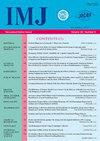肥胖青少年大肠微生物病与肠通透性的评价
Q4 Medicine
引用次数: 0
摘要
肥胖是全球成人和儿童中最常见的非传染性疾病之一。它与代谢综合征、2型糖尿病、非酒精性脂肪肝、心血管疾病等疾病的发生有关。肥胖的发生和发展机制包括慢性低强度炎症、细菌易位和内毒素血症,这可能是由生态失调和肠道通透性增加引起的。本文对74例12 ~ 17岁的肥胖青少年进行了人体测量参数、zonulin、脂多糖、白细胞介素- 6和白细胞介素- 10水平及结肠微生物群指标的研究。对不同性别的大肠菌群与人体测量指标和实验室指标进行相关性分析。值得注意的是,肥胖伴随着78.2%的患者肠道生态失调的形成,专性菌群减少,条件致病性菌群增加。在青少年患者中,与体重正常的青少年相比,白细胞介素- 6水平显著升高,白细胞介素- 10水平有升高的趋势,这是低强度炎症的迹象。与对照组相比,肥胖青少年的zonulin水平显著增加,这可能是肠道通透性增加的证据。据报道,体重、腹部脂肪分布与肠道通透性增加以及低强度炎症的激活呈正相关。在肥胖青少年中,在存在生态失调的情况下,建议通过肠道屏障的修复来协调饮食和风格,纠正肠道生态失调。关键词:糖带蛋白,脂多糖,白细胞介素,微生物群,青少年,肥胖。本文章由计算机程序翻译,如有差异,请以英文原文为准。
EVALUATION OF MICROBIOCENOSIS OF LARGE INTESTINE AND INTESTINAL PERMEABILITY IN OBESE ADOLESCENTS
Obesity is one of the most common non−infectious diseases worldwide among both adults and children. It is associated with the development of diseases such as metabolic syndrome, type 2 diabetes, non−alcoholic fatty liver disease, cardiovascular disease etc. The mechanisms proposed to explain the development and progression of obesity include chronic low−intensity inflammation, bacterial translocation, and endotoxemia, which may resulted from dysbiosis and increased intestinal permeability. To study anthropometric parameters, levels of zonulin, lipopolysaccharide, interleukin−6 and interleukin−10, indices of the colon microbiota, 74 adolescents with obesity aged 12−17 years were examined. The correlation analysis of anthropometric and laboratory indices, between anthropometric ones and those of microflora of a large intestine depending on sex was performed. It is noted that obesity is accompanied by the formation of intestinal dysbiosis in 78.2 % of patients with a decrease in the obligate microflora and an increase in the conditionally pathogenic microflora. In adolescent patients, a significant rise in interleukin−6 levels and a tendency to increase interleukin−10 levels compared with adolescents with normal weight, which is a sign of low−intensity inflammation. There was a significant increase in zonulin levels in obese adolescents compared with those in the control group, that may be an evidence of increased intestinal permeability. Positive correlations have been reported between the body weight, abdominal fat distribution, and increased intestinal permeability as well as activation of low−intensity inflammation. In obese adolescents, in the presence of dysbiotic disorders, it is advisable to harmonize the diet and style and correct intestinal dysbiosis with the intestinal barrier restoration of.
Key words: zonulin, lipopolysaccharide, interleukins, microbiota, adolescents, obesity.
求助全文
通过发布文献求助,成功后即可免费获取论文全文。
去求助
来源期刊

International Medical Journal
医学-医学:内科
自引率
0.00%
发文量
21
审稿时长
4-8 weeks
期刊介绍:
The International Medical Journal is intended to provide a multidisciplinary forum for the exchange of ideas and information among professionals concerned with medicine and related disciplines in the world. It is recognized that many other disciplines have an important contribution to make in furthering knowledge of the physical life and mental life and the Editors welcome relevant contributions from them.
The Editors and Publishers wish to encourage a dialogue among the experts from different countries whose diverse cultures afford interesting and challenging alternatives to existing theories and practices. Priority will therefore be given to articles which are oriented to an international perspective. The journal will publish reviews of high quality on contemporary issues, significant clinical studies, and conceptual contributions, as well as serve in the rapid dissemination of important and relevant research findings.
The International Medical Journal (IMJ) was first established in 1994.
 求助内容:
求助内容: 应助结果提醒方式:
应助结果提醒方式:


